Iron Rims as an Imaging Biomarker in MS: A Systematic Mapping Review
Abstract
1. Introduction
2. Materials and Methods
2.1. Search Strategy and Eligibility Criteria
2.2. Inclusion and Exclusion Criteria
2.3. Data Extraction
3. Results
3.1. Literature Search and Study Characteristics
3.1.1. IRs in Patients with MS and MS Subtypes
3.1.2. IRLs and Lesion Localization
3.1.3. IRLs and Gender-specific Differences
3.1.4. Clinical Relevance of IRLs
3.1.5. IRLs Prevalence
As a Proportion of Total White Matter Lesions’ Count
As a Proportion of Patients Studied
3.1.6. Rim Evolution Overtime
3.1.7. Nature of Rims—Pathology
4. Discussion
4.1. The Presence and Spatial Distribution of IRLs
4.2. Gender Differences in IRLs
4.3. Prevalence of IRLs
4.4. The Evolution of IRLs over Time
4.5. Pathological Nature of IRLs and Disability
5. Conclusions
Supplementary Materials
Funding
Conflicts of Interest
References
- Compston, A.; Coles, A.J. Multiple sclerosis. Lancet 2008, 372, 1502–1517. [Google Scholar] [CrossRef]
- Frischer, J.M.; Bramow, S.; Dal-Bianco, A.; Lucchinetti, C.F.; Rauschka, H.; Schmidbauer, M.; Laursen, H.; Sorensen, P.S.; Lassmann, H. The relation between inflammation and neurodegeneration in multiple sclerosis brains. Brain 2009, 132, 1175–1189. [Google Scholar] [CrossRef]
- Montalban, X.; Tintoré, M.; Swanton, J.; Barkhof, F.; Fazekas, F.; Filippi, M.; Frederiksen, J.; Kappos, L.; Palace, J.; Polman, C.; et al. MRI criteria for MS in patients with clinically isolated syndromes. Neurology 2010, 74, 427–434. [Google Scholar] [CrossRef] [PubMed]
- Polman, C.H.; Reingold, S.C.; Banwell, B.; Clanet, M.; Cohen, J.A.; Filippi, M.; Fujihara, K.; Havrdova, E.; Hutchinson, M.; Kappos, L.; et al. Diagnostic criteria for multiple sclerosis: 2010 Revisions to the McDonald criteria. Ann. Neurol. 2011, 69, 292–302. [Google Scholar] [CrossRef] [PubMed]
- Fazekas, F.; Barkhof, F.; Filippi, M.; Grossman, R.I.; Li, D.K.B.; McDonald, W.I.; McFarland, H.F.; Paty, D.W.; Simon, J.H.; Wolinsky, J.S.; et al. The contribution of magnetic resonance imaging to the diagnosis of multiple sclerosis. Neurology 1999, 53, 448–456. [Google Scholar] [CrossRef] [PubMed]
- Charil, A.; Yousry, T.A.; Rovaris, M.; Barkhof, F.; De Stefano, N.; Fazekas, F.; Miller, D.H.; Montalban, X.; Simon, J.H.; Polman, C.; et al. MRI and the diagnosis of multiple sclerosis: Expanding the concept of “no better explanation”. Lancet Neurol. 2006, 5, 841–852. [Google Scholar] [CrossRef]
- Solomon, A.J.; Bourdette, D.N.; Cross, A.H.; Applebee, A.; Skidd, P.M.; Howard, D.B.; Spain, R.I.; Cameron, M.H.; Kim, E.; Mass, M.K.; et al. The contemporary spectrum of multiple sclerosis misdiagnosis: A multicenter study. Neurology 2016, 87, 1393–1399. [Google Scholar] [CrossRef] [PubMed]
- Sinnecker, T.; Clarke, M.A.; Meier, D.; Enzinger, C.; Calabrese, M.; De Stefano, N.; Pitiot, A.; Giorgio, A.; Schoonheim, M.M.; Paul, F.; et al. Evaluation of the Central Vein Sign as a Diagnostic Imaging Biomarker in Multiple Sclerosis. JAMA Neurol. 2019, 76, 1446. [Google Scholar] [CrossRef]
- Sati, P.; Oh, J.; Constable, R.T.; Evangelou, N.; Guttmann, C.R.G.; Henry, R.G.; Klawiter, E.C.; Mainero, C.; Massacesi, L.; et al.; on behalf of the NAIMS Cooperative The central vein sign and its clinical evaluation for the diagnosis of multiple sclerosis: A consensus statement from the North American Imaging in Multiple Sclerosis Cooperative. Nat. Rev. Neurol. 2016, 12, 714–722. [Google Scholar] [CrossRef]
- Hagemeier, J.; Weinstock-Guttman, B.; Bergsland, N.; Heininen-Brown, M.; Carl, E.; Kennedy, C.; Magnano, C.; Hojnacki, D.; Dwyer, M.G.; Zivadinov, R. Iron Deposition on SWI-Filtered Phase in the Subcortical Deep Gray Matter of Patients with Clinically Isolated Syndrome May Precede Structure-Specific Atrophy. Am. J. Neuroradiol. 2012, 33, 1596–1601. [Google Scholar] [CrossRef]
- Absinta, M.; Sati, P.; Filippi, M.; Ohayon, J.; Cortese, I. Failure of early lesion repair in multiple sclerosis lesions with persistent phase rim. Neurology. 2015, 84 (Suppl. 14), 4–6. [Google Scholar] [CrossRef]
- Absinta, M.; Sati, P.; Schindler, M.; Leibovitch, E.C.; Ohayon, J.; Wu, T.; Meani, A.; Filippi, M.; Jacobson, S.; Cortese, I.C.; et al. Persistent 7-tesla phase rim predicts poor outcome in new multiple sclerosis patient lesions. J. Clin. Investig. 2016, 126, 2597–2609. [Google Scholar] [CrossRef] [PubMed]
- Absinta, M.; Reich, D.S.; Filippi, M. Spring cleaning: Time to rethink imaging research lines in MS? J. Neurol. 2016, 263, 1893–1902. [Google Scholar] [CrossRef] [PubMed]
- Dal-Bianco, A.; Grabner, G.; Kronnerwetter, C.; Weber, M.; Höftberger, R.; Berger, T.; Auff, E.; Leutmezer, F.; Trattnig, S.; Lassmann, H.; et al. Slow expansion of multiple sclerosis iron rim lesions: Pathology and 7 T magnetic resonance imaging. Acta Neuropathol. 2017, 133, 25–42. [Google Scholar] [CrossRef] [PubMed]
- Yao, B.; Hametner, S.; Van Gelderen, P.; Merkle, H.; Chen, C.; Lassmann, H.; Duyn, J.H.; Bagnato, F. 7 Tesla Magnetic Resonance Imaging to Detect Cortical Pathology in Multiple Sclerosis. PLoS ONE 2014, 9, e108863. [Google Scholar] [CrossRef]
- Harrison, D.M.; Li, X.; Liu, H.; Jones, C.K.; Caffo, B.; Calabresi, P.A.; Van Zijl, P. Lesion Heterogeneity on High-Field Susceptibility MRI Is Associated with Multiple Sclerosis Severity. Am. J. Neuroradiol. 2016, 37, 1447–1453. [Google Scholar] [CrossRef]
- Li, X.; Harrison, D.M.; Liu, H.; Jones, C.K.; Oh, J.; Calabresi, P.A.; Van Zijl, P.C. Magnetic susceptibility contrast variations in multiple sclerosis lesions. J. Magn. Reson. Imaging 2016, 43, 463–473. [Google Scholar] [CrossRef]
- Absinta, M.; Sati, P.; Masuzzo, F.; Nair, G.; Sethi, V.; Kolb, H.; Ohayon, J.; Wu, T.; Cortese, I.C.M.; Reich, D.S. Association of Chronic Active Multiple Sclerosis Lesions With Disability In Vivo. JAMA Neurol. 2019, 76, 1474–1483. [Google Scholar] [CrossRef]
- Chawla, S.; Kister, I.; Wuerfel, J.; Brisset, J.-C.; Liu, S.; Sinnecker, T.; Dusek, P.; Haacke, E.; Paul, F.; Ge, Y. Iron and Non-Iron-Related Characteristics of Multiple Sclerosis and Neuromyelitis Optica Lesions at 7T MRI. Am. J. Neuroradiol. 2016, 37, 1223–1230. [Google Scholar] [CrossRef]
- Wuerfel, J.; Sinnecker, T.; Ringelstein, E.B.; Jarius, S.; Schwindt, W.; Niendorf, T.; Paul, F.; Kleffner, I.; Dörr, J. Lesion morphology at 7 Tesla MRI differentiates Susac syndrome from multiple sclerosis. Mult. Scler. J. 2012, 18, 1592–1599. [Google Scholar] [CrossRef]
- Hosseini, Z.; Matusinec, J.; Rudko, D.; Liu, J.; Kwan, B.; Salehi, F.; Sharma, M.; Kremenchutzky, M.; Menon, R.S.; Drangova, M. Morphology-Specific Discrimination between MS White Matter Lesions and Benign White Matter Hyperintensities Using Ultra-High-Field MRI. Am. J. Neuroradiol. 2018, 39, 1473–1479. [Google Scholar] [CrossRef]
- Frischer, J.M.; Ms, S.D.W.; Guo, Y.; Kale, N.; Parisi, J.E.; Pirko, I.; Mandrekar, J.; Bramow, S.; Metz, I.; Brück, W.; et al. Clinical and pathological insights into the dynamic nature of the white matter multiple sclerosis plaque. Ann. Neurol. 2015, 78, 710–721. [Google Scholar] [CrossRef] [PubMed]
- Clarke, M.; Samaraweera, A.P.; Falah, Y.; Pitiot, A.; Allen, C.M.; Dineen, R.A.; Tench, C.R.; Morgan, P.S.; Evangelou, N. Single Test to ARrive at Multiple Sclerosis (STAR-MS) diagnosis: A prospective pilot study assessing the accuracy of the central vein sign in predicting multiple sclerosis in cases of diagnostic uncertainty. Mult. Scler. J. 2019, 26, 433–441. [Google Scholar] [CrossRef]
- Wiggermann, V.; Torres, E.H.; Vavasour, I.M.; Moore, G.W.; Laule, C.; Mackay, A.L.; Li, D.K.; Traboulsee, A.; Rauscher, A. Magnetic resonance frequency shifts during acute MS lesion formation. Neurology 2013, 81, 211–218. [Google Scholar] [CrossRef] [PubMed]
- Wiggermann, V.; Lee, L.E.; Hernandez-Torres, E.; Li DK, B.; Mackay, A.L.; Vavasour, I.M.; Laule1, C.; Traboulsee, A.; Rauscher, A. MR frequency shift imaging demonstrates that iron accumulation is rare in multiple sclerosis lesions. Mult Scler. 2014, 20 (Suppl. 1), 298. [Google Scholar] [CrossRef]
- Pulli, B.; Chen, J.W. Imaging Neuroinflammation—From Bench to Bedside. J. Clin. Cell. Immunol. 2014, 5, 226. [Google Scholar] [CrossRef] [PubMed]
- Luchetti, S.; Fransen, N.L.; Van Eden, C.G.; Ramaglia, V.; Mason, M.; Huitinga, I. Progressive multiple sclerosis patients show substantial lesion activity that correlates with clinical disease severity and sex: A retrospective autopsy cohort analysis. Acta Neuropathol. 2018, 135, 511–528. [Google Scholar] [CrossRef] [PubMed]
- Kilsdonk, I.D.; Lopez-Soriano, A.; Kuijer, J.; De Graaf, W.L.; Castelijns, J.A.; Polman, C.H.; Luijten, P.R.; Geurts, J.J.J.G.; Barkhof, F.; Wattjes, M.P. Morphological features of MS lesions on FLAIR* at 7 T and their relation to patient characteristics. J. Neurol. 2014, 261, 1356–1364. [Google Scholar] [CrossRef]
- Yao, B.; Ikonomidou, V.N.; Cantor, F.K.; Ohayon, J.M.; Duyn, J.; Bagnato, F. Heterogeneity of Multiple Sclerosis White Matter Lesions Detected With T2*-Weighted Imaging at 7.0 Tesla. J. Neuroimaging 2015, 25, 799–806. [Google Scholar] [CrossRef] [PubMed]
- Llufriu, S.; Pujol, T.; Blanco, Y.; Hankiewicz, K.; Squarcia, M.; Berenguer, J.; Villoslada, P.; Graus, F.; Saiz, A. T2 hypointense rims and ring-enhancing lesions in MS. Mult. Scler. J. 2010, 16, 1317–1325. [Google Scholar] [CrossRef]
- Treaba, C.; Granberg, T.; Herranz, E.; Mercaldo, N.; Barletta, V.; Mehndiratta, A.; Ouellette, R.; Sloane, J.; Kinkel, R.; Mainero, C. The relevance of 7-Tesla paramagnetic rim lesions in patients with multiple sclerosis. Mult. Scler. J. 2019, 25, 680–681. [Google Scholar]
- Dal-Bianco, A.; Kolbrink, S.; Pusswald, G.; Grabner, G.; Kronnerwetter, C.; Reiter, G.; Weber, M.; Kornek, B.; Zebenholzer, K.; Schmied, C.; et al. Do 7T observed iron rim lesions in patients with multiple sclerosis serve as a marker for neuropsychological deficits? Mult. Scler. J. 2019, 25, 732. [Google Scholar]
- Ontaneda, D.; Fox, R.J. Progressive multiple sclerosis. Curr. Opin. Neurol. 2015, 28, 237–243. [Google Scholar] [CrossRef] [PubMed]
- Blindenbacher, N.; Brunner, E.; Asseyer, S.; Scheel, M.; Siebert, N.; Rasche, L.; Bellmann-Strobl, J.; Brandt, A.U.; Ruprecht, K.; Meier, D.; et al. Evaluation of the ‘ring sign’ and the ‘core sign’ as a magnetic resonance imaging marker of disease activity and progression in clinically isolated syndrome and early multiple sclerosis. Mult. Scler. J. Exp. Transl. Clin. 2020, 6. [Google Scholar] [CrossRef] [PubMed]
- Clarke, M.; Pessini Ferreira, L.M.; Pareto, D.; Arrambide, G.; Alberich, M.; Crescenzo, F.; Vidal, A.G.; Tintore, M.; Auger, C.; Evangelou, N.; et al. The central vein sign and iron rings: Insights from a large cohort of patients with multiple sclerosis and mimicking disorders. Mult. Scler. J. 2019, 25, 38–39. [Google Scholar]
- Yablonskiy, D.A.; Luo, J.; Sukstanskii, A.L.; Iyer, A.; Cross, A.H. Biophysical mechanisms of MRI signal frequency contrast in multiple sclerosis. Proc. Natl. Acad. Sci. USA 2012, 109, 14212–14217. [Google Scholar] [CrossRef]
- Chen, W.; Gauthier, S.A.; Gupta, A.; Comunale, J.; Liu, T.; Wang, S.; Pei, M.; Pitt, D.; Wang, Y. Quantitative Susceptibility Mapping of Multiple Sclerosis Lesions at Various Ages. Radiology 2014, 271, 183–192. [Google Scholar] [CrossRef]
- Schwartz, K.M.; Erickson, B.J.; Lucchinetti, C. Pattern of T2 hypointensity associated with ring-enhancing brain lesions can help to differentiate pathology. Neuroradiology 2006, 48, 143–149. [Google Scholar] [CrossRef]
- Sinnecker, T.; Schumacher, S.; Mueller, K.; Pache, F.; Dusek, P.; Harms, L.; Ruprecht, K.; Nytrova, P.; Chawla, S.; Niendorf, T.; et al. MRI phase changes in multiple sclerosis vs neuromyelitis optica lesions at 7T. Neurol. Neuroimmunol. Neuroinflammation 2016, 3, e259. [Google Scholar] [CrossRef]
- Suthiphosuwan, S.; Sati, P.; Absinta, M.; Guenette, M.; Reich, D.S.; Bharatha, A.; Oh, J. Paramagnetic Rim Sign in Radiologically Isolated Syndrome. JAMA Neurol. 2020, 77, 653. [Google Scholar] [CrossRef]
- Tolaymat, B.; Zheng, W.; Chen, H.; Choi, S.; Li, X.; Harrison, D. Sex-specific Differences in Rim Appearance of Multiple Sclerosis lesions on Quantitative Susceptibility Mapping. Neurology 2020, 92 (Suppl. 15), 102317. [Google Scholar] [CrossRef]
- Hametner, S.; Dal-Bianco, A.; Trattnig, S.; Lassmann, H. Iron related changes in MS lesions and their validity to characterize MS lesion types and dynamics with Ultra-high field magnetic resonance imaging. Brain Pathol. 2018, 28, 743–749. [Google Scholar] [CrossRef]
- Kilsdonk, I.D.; Wattjes, M.P.; Lopez-Soriano, A.; Kuijer, J.P.A.; De Jong, M.C.; De Graaf, W.L.; Conijn, M.M.A.; Polman, C.H.; Luijten, P.R.; Geurts, J.J.G.; et al. Improved differentiation between MS and vascular brain lesions using FLAIR* at 7 Tesla. Eur. Radiol. 2013, 24, 841–849. [Google Scholar] [CrossRef] [PubMed]
- Kang, Y.; Schlyer, D.; Kaunzner, U.W.; Kuceyeski, A.; Kothari, P.J.; Gauthier, S.A. Comparison of two different methods of image analysis for the assessment of microglial activation in patients with multiple sclerosis using (R)-[N-methyl-carbon-11]PK11195. PLoS ONE 2018, 13, e0201289. [Google Scholar] [CrossRef] [PubMed]
- Absinta, M.M.; Sati, P.P.; Gaitán, M.I.M.; Maggi, P.; Cortese, I.C.M.I.; Filippi, M.M.; Reich, D.S. Seven-tesla phase imaging of acute multiple sclerosis lesions: A new window into the inflammatory process. Ann. Neurol. 2013, 74, 669–678. [Google Scholar] [CrossRef] [PubMed]
- Absinta, M.; Bhagavatheeshwaran, G.; Sati, P. Longitudinal MRI history of lesion repair based on the presence or absence of a 7t paramagnetic RIM. In Proceedings of the 3rd Annual Americas Committee for Treatment and Research in Multiple Sclerosis Forum, ACTRIMS 2018; SAGE Publications Ltd., San Diego, CA, USA, 1–3 February 2018; p. 62. [Google Scholar] [CrossRef]
- Chawla, S.; Kister, I.; Sinnecker, T.; Wuerfel, J.; Brisset, J.-C.; Paul, F.; Ge, Y. Longitudinal study of multiple sclerosis lesions using ultra-high field (7T) multiparametric MR imaging. PLoS ONE 2018, 13, e0202918. [Google Scholar] [CrossRef]
- Lucchinetti, C.F.; Gavrilova, R.H.; Metz, I.; Parisi, J.E.; Scheithauer, B.W.; Weigand, S.; Thomsen, K.; Mandrekar, J.; Altintas, A.; Erickson, B.J.; et al. Clinical and radiographic spectrum of pathologically confirmed tumefactive multiple sclerosis. Brain 2008, 131, 1759–1775. [Google Scholar] [CrossRef]
- Lucchinetti, C.; Altintasm, A.; Wegner, C.; Silvia Menk, S.; Lassmann, H.; Andreas, B. Magnetic Resonance Imaging Correlates of Multiple Sclerosis Pathologic Subtypes. Ann. Neurol. 2003, 54 (Suppl. 7), S37. [Google Scholar]
- Oh, J.; Suthiphosuwan, S.; Guenette, M.; Absinta, M.; Reich, D.; Bharatha, A. The central vein sign and paramagnetic rim sign in white matter lesions of radiologically isolated syndrome. Neurology 2019, 92 (Suppl. 15), 420. [Google Scholar] [CrossRef]
- Blaabjerg, M.; Ruprecht, K.; Sinnecker, T.; Kondziella, D.; Niendorf, T.; Kerrn-Jespersen, B.M.; Lindelof, M.; Lassmann, H.; Kristensen, B.W.; Paul, F.; et al. Widespread inflammation in CLIPPERS syndrome indicated by autopsy and ultra-high-field 7T MRI. Neurol. Neuroimmunol. Neuroinflammation 2016, 3, e226. [Google Scholar] [CrossRef]
- Bian, W.; Harter, K.; E Hammond-Rosenbluth, K.; Lupo, J.M.; Xu, D.; Kelley, D.A.; Vigneron, D.B.; Nelson, S.J.; Pelletier, D. A serial in vivo 7T magnetic resonance phase imaging study of white matter lesions in multiple sclerosis. Mult. Scler. J. 2013, 19, 69–75. [Google Scholar] [CrossRef] [PubMed]
- Absinta, M.; Sati, P.; Reich, D.S. Advanced MRI and staging of multiple sclerosis lesions. Nat. Rev. Neurol. 2016, 12, 358–368. [Google Scholar] [CrossRef] [PubMed]
- Yao, Y.; Nguyen, T.; Pandya, S.; Rua, S.H.; Kuceyeski, A.; Wang, Y. MS lesions demonstrating a QSM hyperintense-rim have more myelin loss compared to those without a QSM hyperintense-rim. Neurology 2017, 88 (Suppl. 16), 354. [Google Scholar]
- Tillema, J.-M.; Weigand, S.D.; Dayan, M.; Shu, Y.; Kantarci, O.H.; Lucchinetti, C.F.; Port, J.D. Dark Rims: Novel Sequence Enhances Diagnostic Specificity in Multiple Sclerosis. Am. J. Neuroradiol. 2018, 39, 1052–1058. [Google Scholar] [CrossRef]
- Li, Y.-X.; Shi, Z.; Aibaidula, A.; Chen, H.; Tang, Q.; Li, K.K.-W.; Chung, N.Y.-F.; Chan, D.T.-M.; Poon, W.S.; Mao, Y.; et al. Not all 1p/19q non-codeleted oligodendroglial tumors are astrocytic. Oncotarget 2016, 7, 64615–64630. [Google Scholar] [CrossRef]
- Absinta, M.; Sati, P.; Fechner, A.; Schindler, M.K.; Reich, D.S. 3T MRI detection of 7T paramagnetic rims in multiple sclerosis lesions: A step toward the clinical application. Mult. Scler. J. 2017, 23 (Suppl. 3), 79–80. [Google Scholar] [CrossRef]
- Kaunzner, U.W.; Kang, Y.; Zhang, S.; Morris, E.; Yao, Y.; Pandya, S.; Rua, S.M.H.; Park, C.; Gillen, K.M.; Nguyen, T.D.; et al. Quantitative susceptibility mapping identifies inflammation in a subset of chronic multiple sclerosis lesions. Brain 2019, 142, 133–145. [Google Scholar] [CrossRef]
- Kuhlmann, T.; Ludwin, S.; Prat, A.; Antel, J.; Brück, W.; Lassmann, H. An updated histological classification system for multiple sclerosis lesions. Acta Neuropathol. 2017, 133, 13–24. [Google Scholar] [CrossRef]
- Elliott, C.; Wolinsky, J.S.; Hauser, S.L.; Kappos, L.; Barkhof, F.; Bernasconi, C.; Wei, W.; Belachew, S.; Arnold, D.L. Slowly expanding/evolving lesions as a magnetic resonance imaging marker of chronic active multiple sclerosis lesions. Mult. Scler. J. 2018, 25, 1915–1925. [Google Scholar] [CrossRef]
- Haacke, E.M.; Mittal, S.; Wu, Z.; Neelavalli, J.; Cheng, Y.-C. Susceptibility-Weighted Imaging: Technical Aspects and Clinical Applications, Part 1. Am. J. Neuroradiol. 2009, 30, 19–30. [Google Scholar] [CrossRef]
- Haacke, E.M.; Xu, Y.; Cheng, Y.-C.N. Susceptibility weighted imaging (SWI). Magn. Reson. Med. 2004, 52, 612–618. [Google Scholar] [CrossRef] [PubMed]
- Bagnato, F.; Hametner, S.; Yao, B.; Van Gelderen, P.; Merkle, H.; Cantor, F.K.; Lassmann, H.; Duyn, J.H. Tracking iron in multiple sclerosis: A combined imaging and histopathological study at 7 Tesla. Brain 2011, 134, 3599–3612. [Google Scholar] [CrossRef] [PubMed]
- Sati, P.; George, I.C.; Shea, C.D.; Gaitán, M.I.; Reich, D.S. FLAIR*: A Combined MR Contrast Technique for Visualizing White Matter Lesions and Parenchymal Veins. Radiology 2012, 265, 926–932. [Google Scholar] [CrossRef] [PubMed]
- Kister, I.; Chawla, S.; Wuerfel, J.T.; Sinnecker, T.; Paul, F.; Ge, Y. Longitudinal study of MS lesions using multi-parametric ultra-high field (7Tesla) MRI. Mult Scler. J. 2016, 22 (Suppl. 3), 240. [Google Scholar] [CrossRef]
- Casini, G. Are Periventricular Lesions Specific for Multiple Sclerosis? J. Neurol. Neurophysiol. 2013, 4, 150. [Google Scholar] [CrossRef]
- Dal-Bianco, A.; Grabner, G.; Kronnerwetter, C.; Weber, M.; Berger, T.; Leutmezer, F.; Rommer, P.; Trattnig, S.; Lassmann, H.; Hametner, S. Iron rim lesions in multiple sclerosis at 7 Tesla magnetic resonance imaging: A 7 year prospective longitudinal study. Mult Scler. J. 2019, 25, 50–51. [Google Scholar]
- Filippi, M.; Preziosa, P.; Banwell, B.L.; Barkhof, F.; Ciccarelli, O.; De Stefano, N.; Geurts, J.J.G.; Paul, F.; Reich, D.S.; Toosy, A.T.; et al. Assessment of lesions on magnetic resonance imaging in multiple sclerosis: Practical guidelines. Brain 2019, 142, 1858–1875. [Google Scholar] [CrossRef]
- Higgins, J.; Altman, D. Assessing Risk of Bias in Included Studies. In Cochrane Handbook for Systematic Reviews of Interventions; John Wiley & Sons, Ltd.: Chichester, UK, 2017. [Google Scholar]
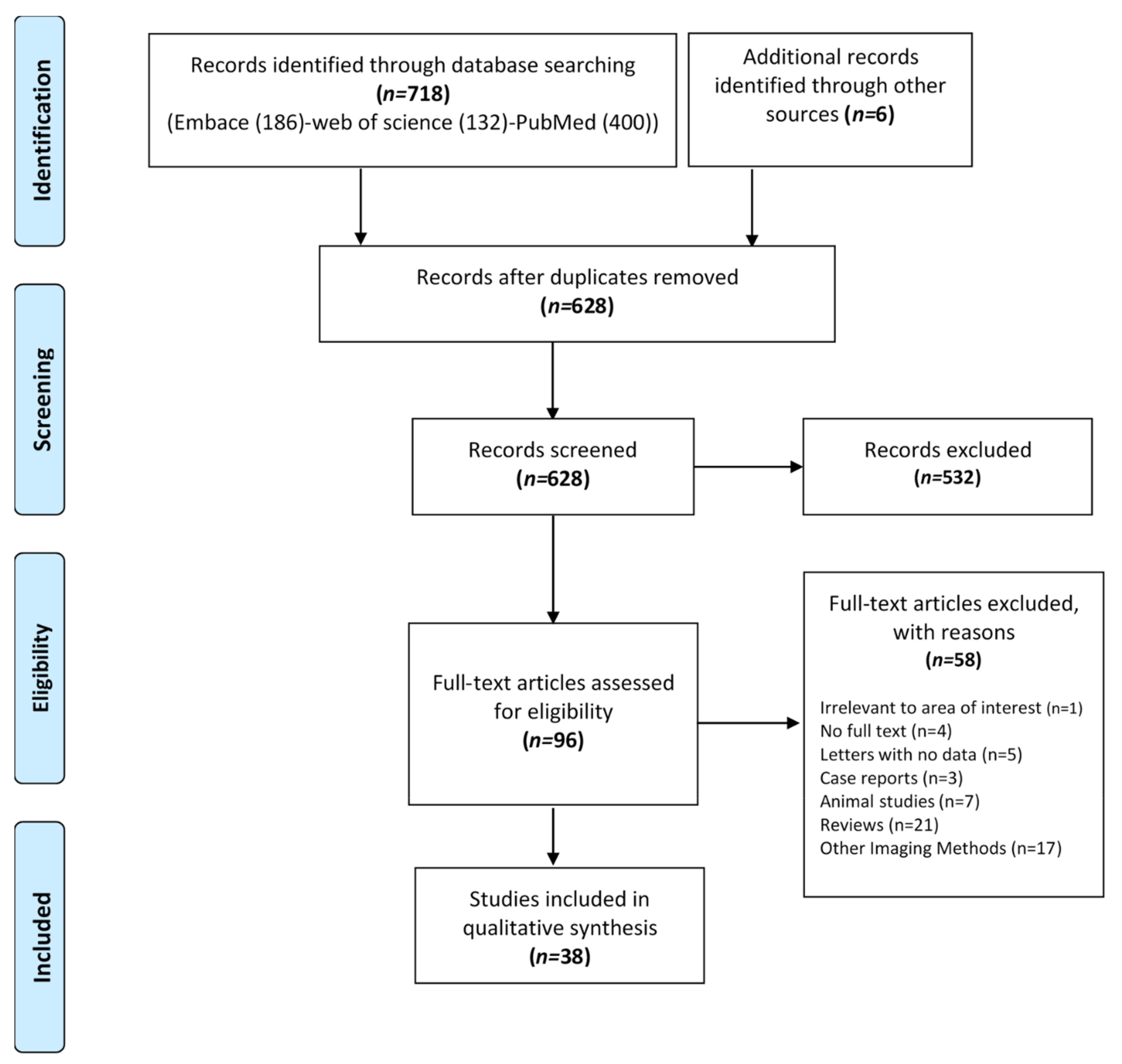
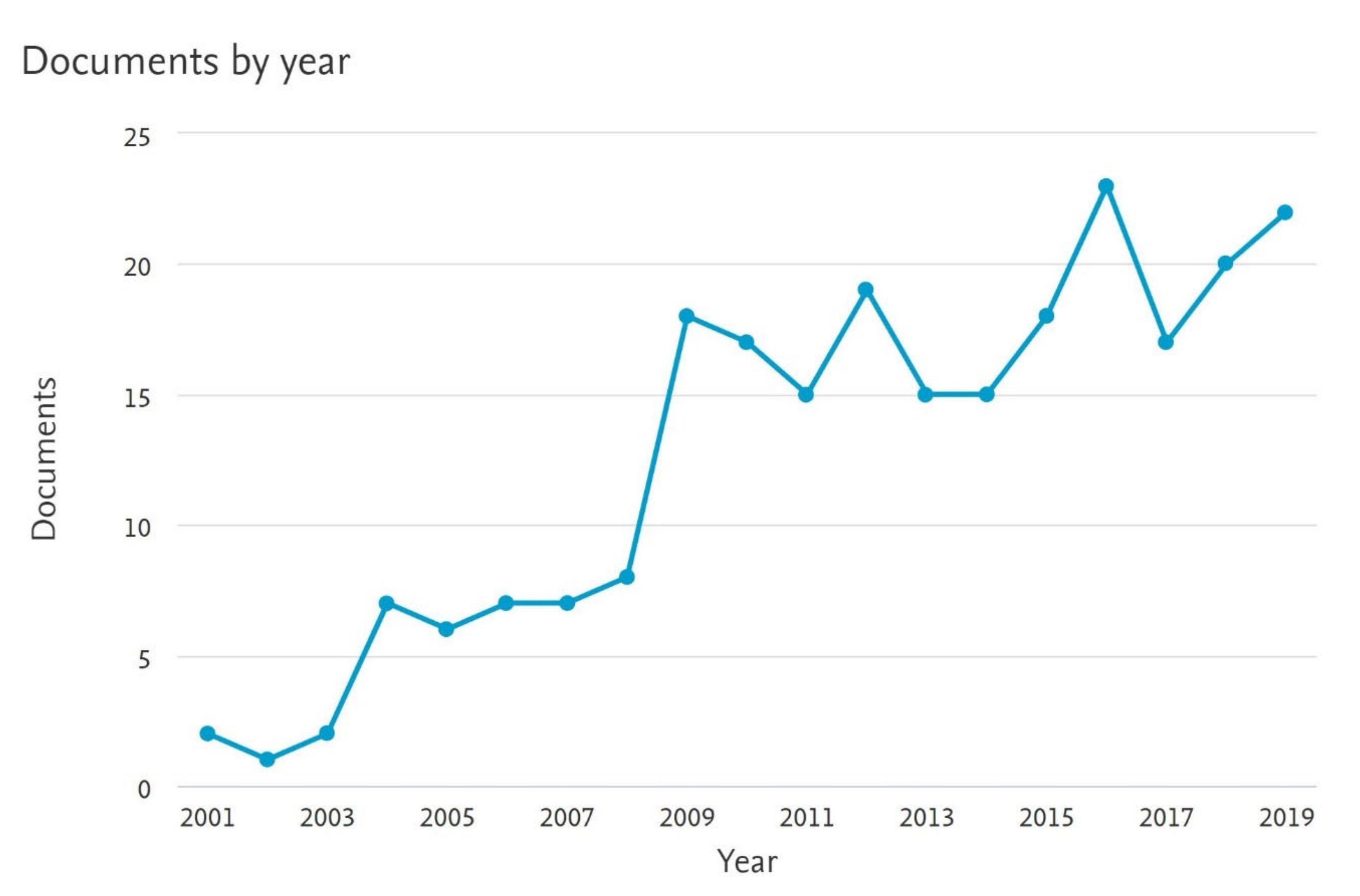
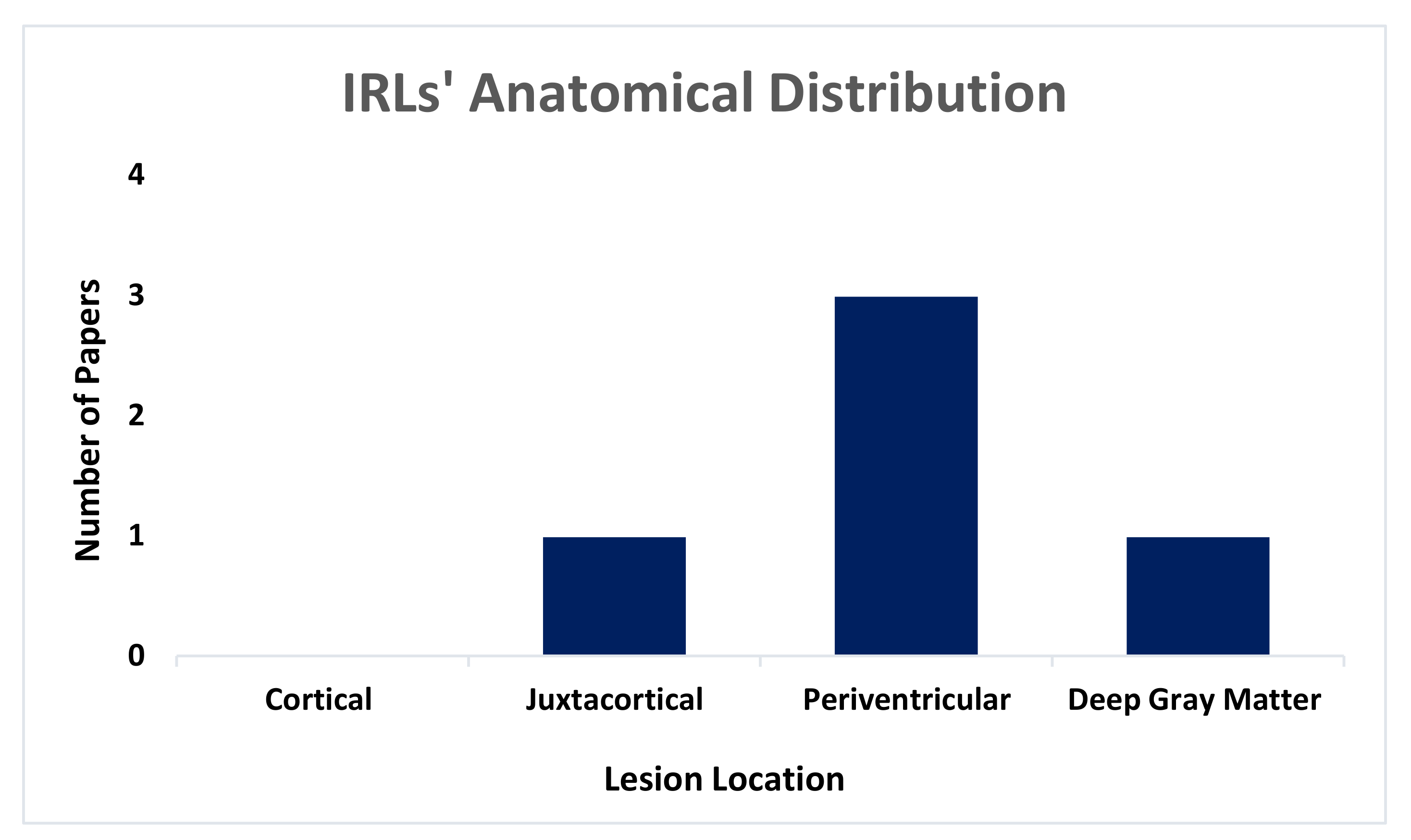
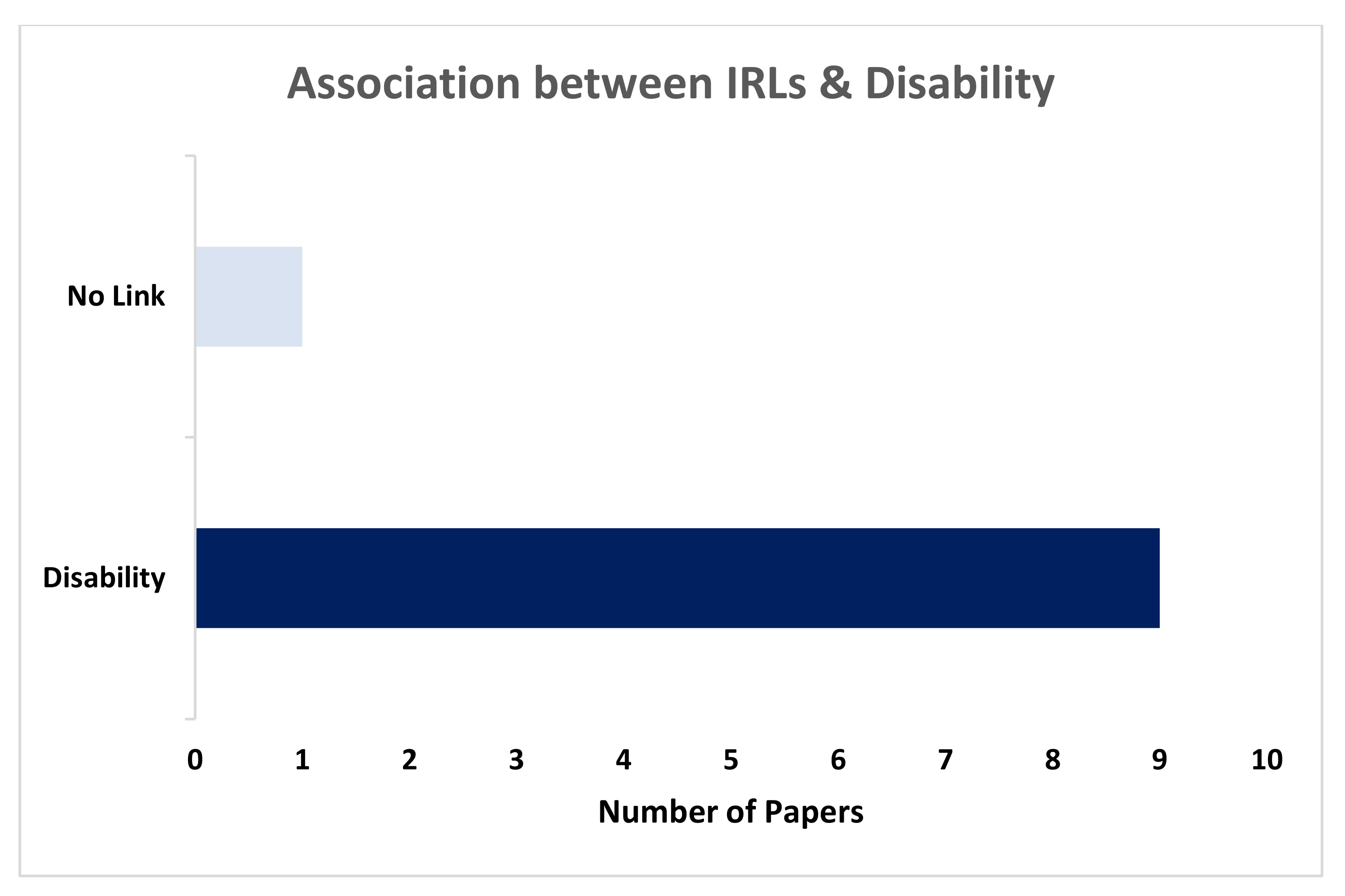
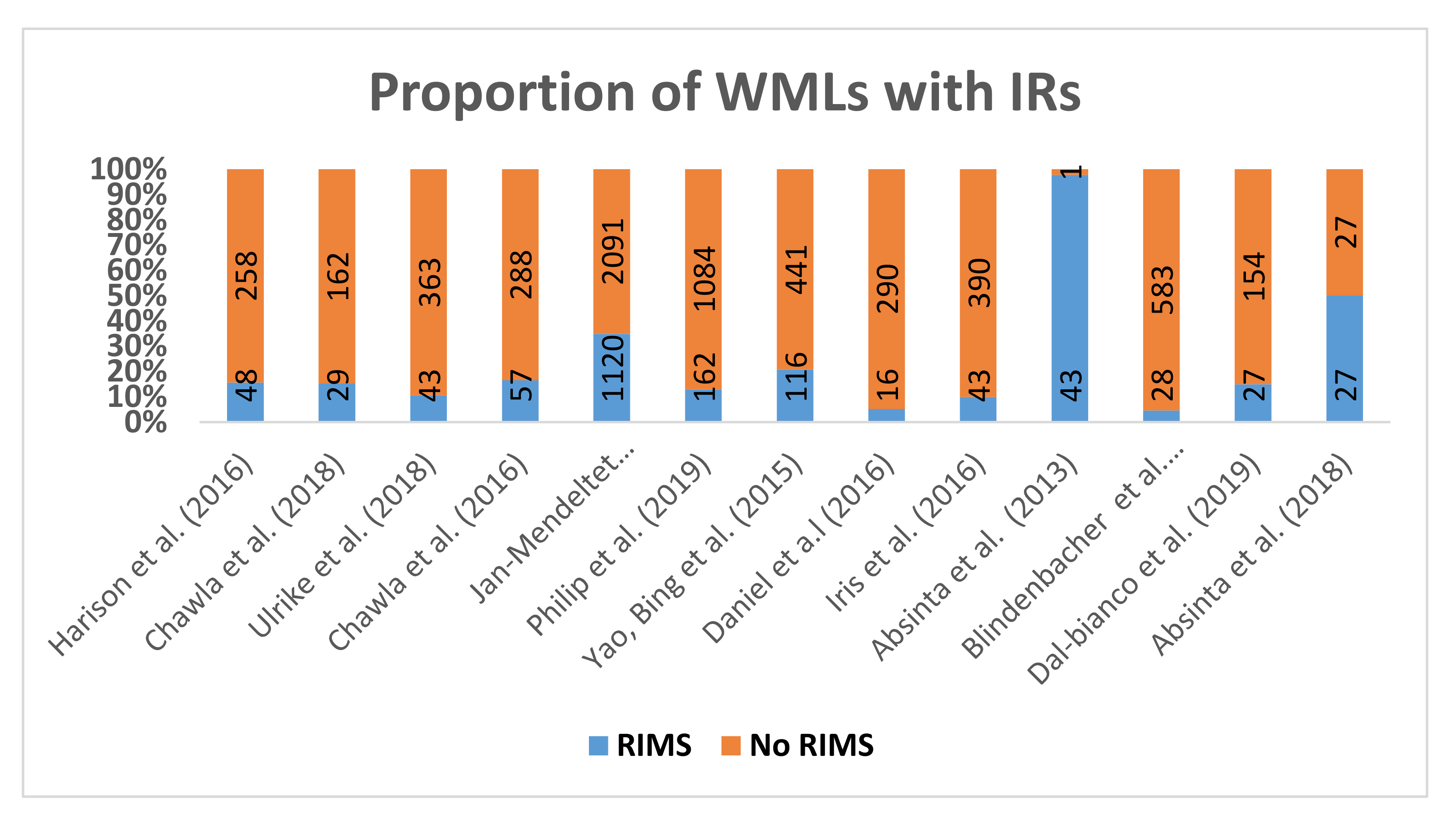
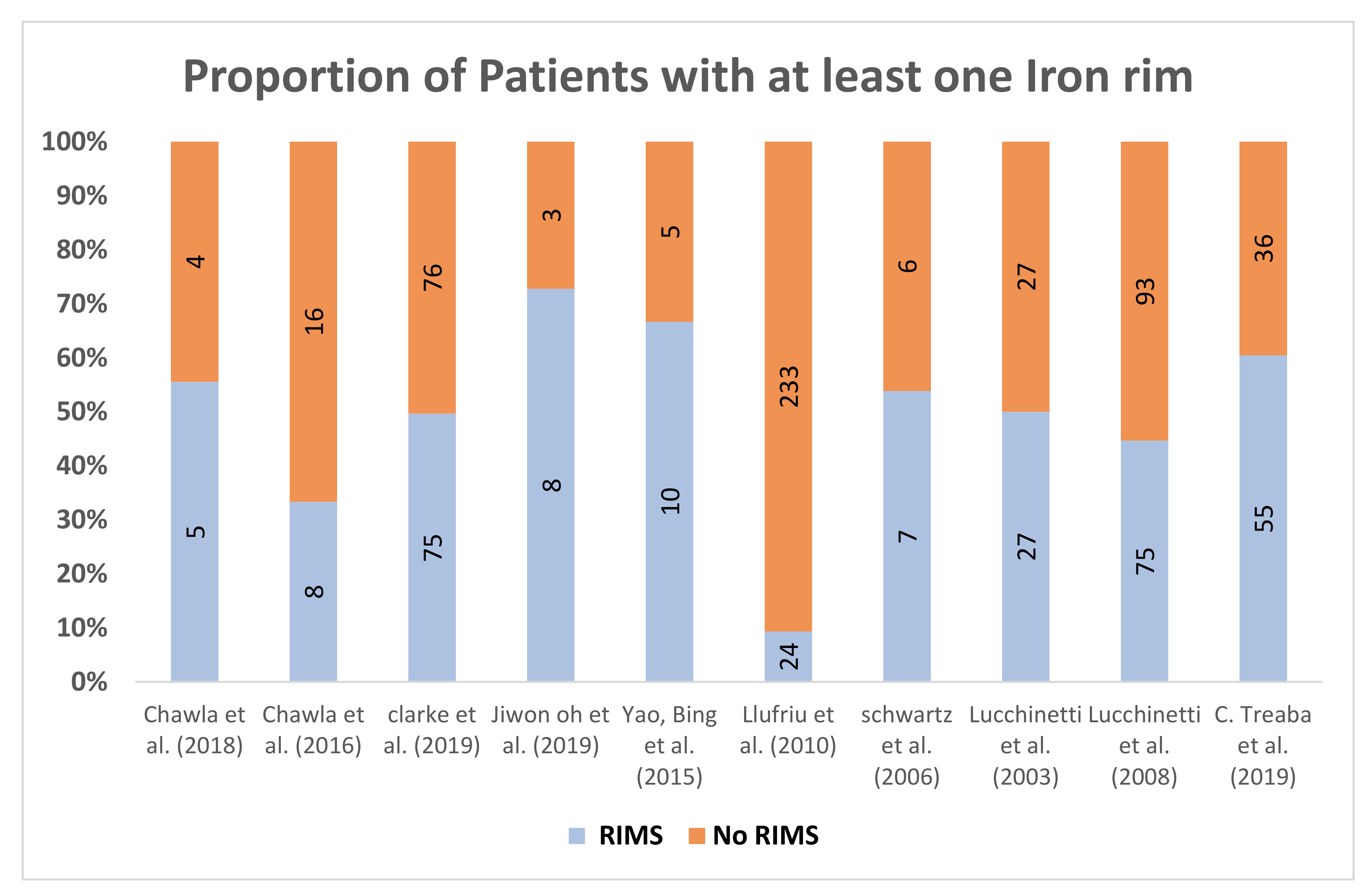
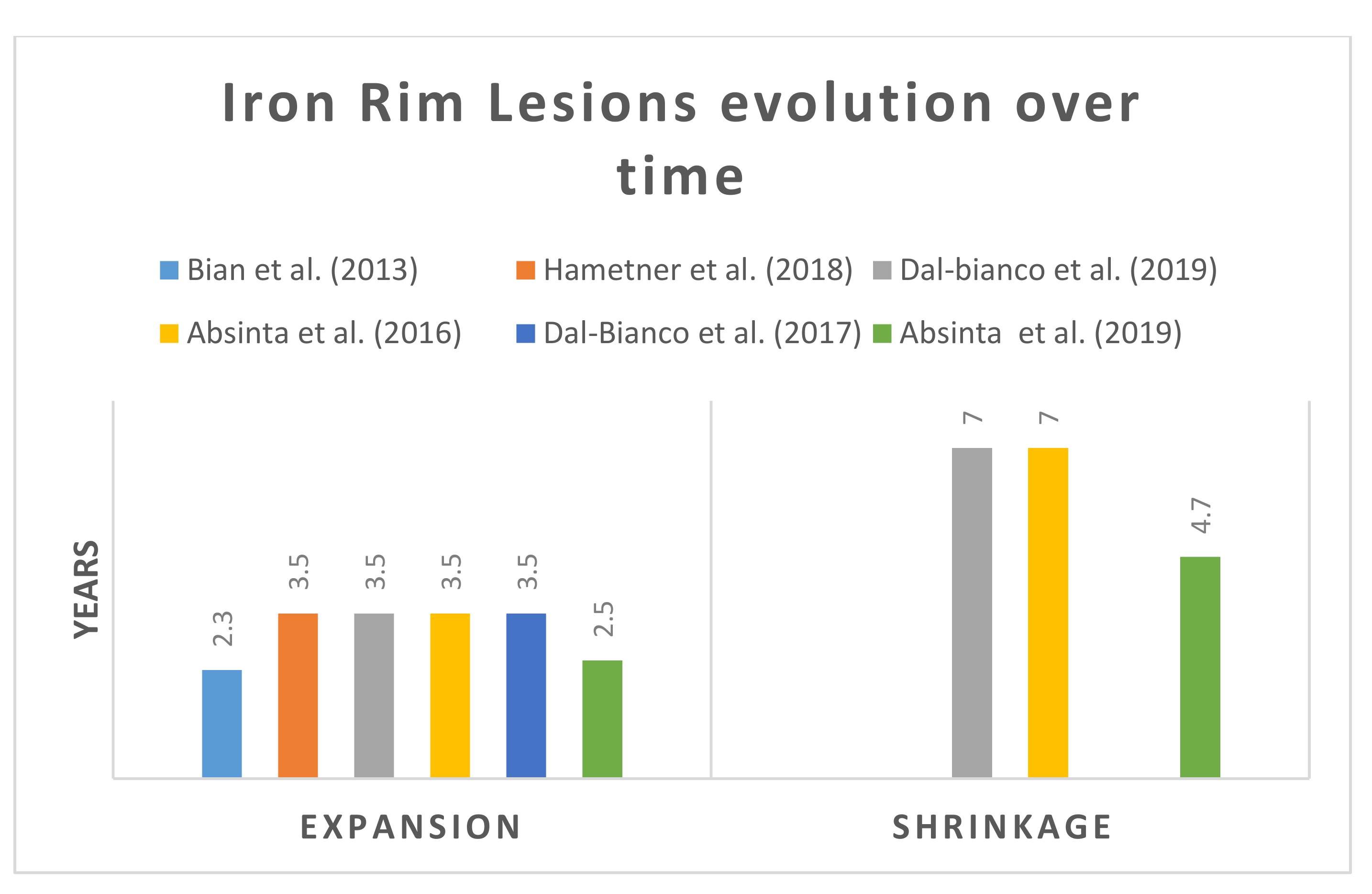
| Inclusion | Exclusion |
|---|---|
| Brain studies on WMLs with rims presence | Studies published before 2001 |
| Pathological studies | Animal studies |
| Studies published in peer-review journals or the grey literature | Case reports, reviews or systematic literature reviews and qualitative studies, opinion pieces, editorials comments, and news |
| Literature is written in English MRIs field strength reported |
Publisher’s Note: MDPI stays neutral with regard to jurisdictional claims in published maps and institutional affiliations. |
© 2020 by the authors. Licensee MDPI, Basel, Switzerland. This article is an open access article distributed under the terms and conditions of the Creative Commons Attribution (CC BY) license (http://creativecommons.org/licenses/by/4.0/).
Share and Cite
AlTokhis, A.I.; AlOtaibi, A.M.; Felmban, G.A.; Constantinescu, C.S.; Evangelou, N. Iron Rims as an Imaging Biomarker in MS: A Systematic Mapping Review. Diagnostics 2020, 10, 968. https://doi.org/10.3390/diagnostics10110968
AlTokhis AI, AlOtaibi AM, Felmban GA, Constantinescu CS, Evangelou N. Iron Rims as an Imaging Biomarker in MS: A Systematic Mapping Review. Diagnostics. 2020; 10(11):968. https://doi.org/10.3390/diagnostics10110968
Chicago/Turabian StyleAlTokhis, Amjad I., Abdulmajeed M. AlOtaibi, Ghadah A. Felmban, Cris S. Constantinescu, and Nikos Evangelou. 2020. "Iron Rims as an Imaging Biomarker in MS: A Systematic Mapping Review" Diagnostics 10, no. 11: 968. https://doi.org/10.3390/diagnostics10110968
APA StyleAlTokhis, A. I., AlOtaibi, A. M., Felmban, G. A., Constantinescu, C. S., & Evangelou, N. (2020). Iron Rims as an Imaging Biomarker in MS: A Systematic Mapping Review. Diagnostics, 10(11), 968. https://doi.org/10.3390/diagnostics10110968







